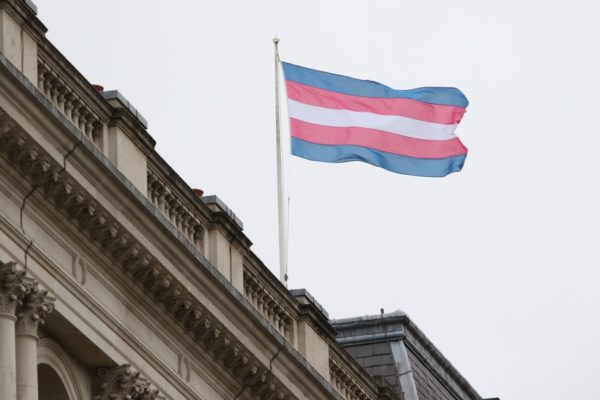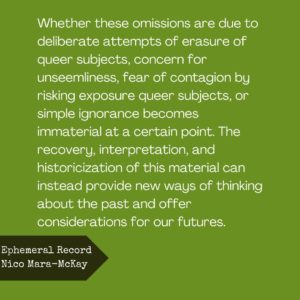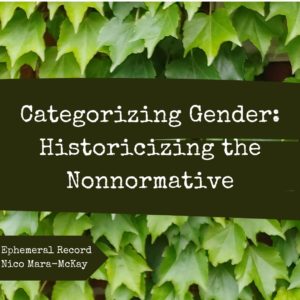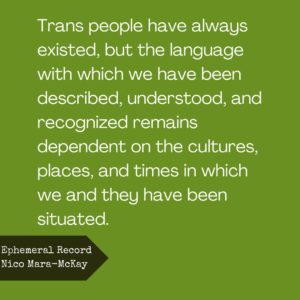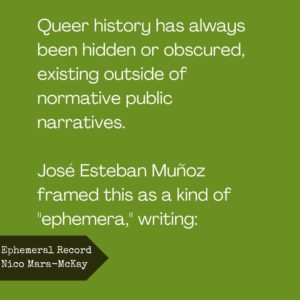This paper was first presented at the conference Moving Trans History Forward on Friday, 12 March 2021.
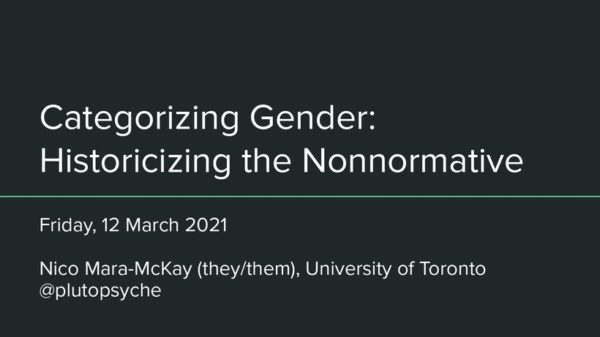
A brief content warning: There will be use of outdated language, misgendering, and discussions of violence in this presentation, so please take care.
Trans people have always existed, but the language with which we have been described, understood, and recognized remains dependent on the cultures, places, and times in which we and they have been situated. Indeed, here in North America, the discourse around what it means to be transgender has develloped dramatically over the past thirty years. For the purposes of this paper, I am following Susan Stryker’s broad understanding of the adjectives “trans” or “transgender” in reference to “the movement across a socially imposed [gendered] boundar[ies] away from an unchosen starting place.” Meaning, a person whose lived gender does not match what was assigned to them at birth. Yet, there remain those who do not believe that the term “transgender” should be used prior to its 1971 coinage. However, it would be more absurd to assume that these people, though unnamed and unrecognized, did not exist.
Queer history has always been hidden or obscured, existing outside of normative public narratives. José Esteban Muñoz framed this as a kind of “ephemera,” writing:
Instead of being clearly available as visible evidence, queerness has instead existed as innuendo, gossip, fleeting moments, and performances that are meant to be interacted with by those within its epistemological sphere — while evaporating at the touch of those who would eliminate queer possibility.
José Esteban Muñoz
Whether these omissions are due to deliberate attempts of erasure of queer subjects, concern for unseemliness, fear of contagion by risking exposure queer subjects, or simple ignorance becomes immaterial at a certain point. The recovery, interpretation, and historicization of this material can instead provide new ways of thinking about the past and offer considerations for our futures.
In my discipline (I’m a medieval historian), first-person accounts of what it meant to be gender nonconforming remain elusive in medieval western Europe. Additionally, many of the contemporary sources medieval historians rely on to tell us something about what it meant to be trans are hostile, including the court records that I will be discussing today. In some cases, the historians themselves have also been hostile towards the people they uncovered in their research. Some historians did not have the language or theoretical background to interpret the cases they uncovered, and so they did not even consider transness a possibility until relatively recently. However, a few medievalists have since undergone changes in how they understood the material they approached in new and more empathetic ways. The language around “trans” has changed and will likely continue to do so. Trans people do indeed appear in medieval sources, both in imagined and real contexts.
There are numerous stories of monks who were assigned female at birth who entered monasteries and took orders, and a few of them even attained sainthood. These stories were widely circulated and translated into a number of languages. In Byzantine Intersectionality: Sexuality, Gender, and Race in the Middle Ages, Roland Betancourt counts thirteen foundational stories, out of which thirty-four stories emerge where people who were assigned female at birth present as male. Many modern historians tend to refer to these figures as “transvestites,” “cross-dressers,” or suggest they were undertaking a “disguise” of some sort, rather than accepting that these people presented and lived as male because they were male; what we would today call “trans men.” Betancourt notes that many of these stories present these trans monks as possessing a “different kind of subjectivity,” though there often is not enough information available in the source material to definitively state how the subject would have identified.
Many such monks were ascetics who undertook extreme poverty and fasting, they often withdrew from the world and lived in solitude. Trans masculine ascetics were often assumed by their contemporaries to be eunuchs, which explained why they could not grow beards and why they did not possess the expected genitals. Extreme fasting would also stop one’s menstrual period and reduce the size of one’s breasts, altering the physical features of the body. Betancourt suggests that such practices may have been undertaken deliberately in order to present a more masculine appearance.
To read the full post, “Categorizing Gender: Historicizing the Nonnormative,” please subscribe to Ephemeral Record.

